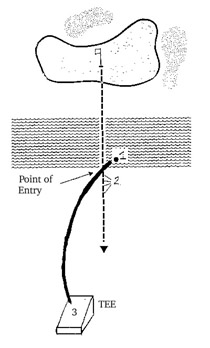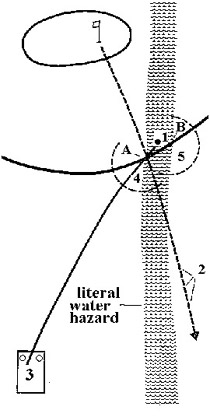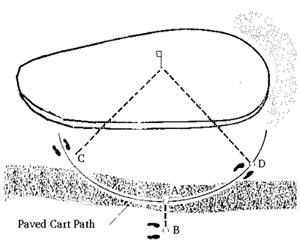

| Directions: using only the index to the rules of golf located at the
back of the rule book, fill in the following information. |
| 1. I lifted my ball from ground under repair and took the nearest point of relief, but when I dropped my ball it rolled back into the ground
under repair. What do I do now? |
| 2. My ball is in the bunker under all the leaves. Can I
move the leaves away? |
| 3. My first tee shot went out of bounds. Do I play my next
shot before my opponent or after. |
| 4. Can I take three clubs with me to go into the bunker before I decide
which one I use to play the ball? What do I do with the two
clubs I don�t want to use? |
| 5. I putted my ball and a dog ran onto the putting green and picked
it up and ran away with it. Now what do I do? |
| 6. My ball went into the woods and when my fellow competitor and I
were searching for it, she stepped on my ball. Now what do we do? |
| 7. My ball is lost in the casual water. What do I do now? |
| 8. My husband and I were playing a foursomes match and he hit his tee
shot out of bounds. Where do I play it? |
| 9. When I marked my ball on the putting green and tapped down the ball
marker it stuck to the bottom of my putter. Now what do I do? |
| 10. I think my opponent has an improper grip on her putter. Where do I look to find out? |
|
|
playerstrikes the ball more then once. |
|
|
In storke play the players ball strikes the players golf bag. |
|
|
in stroke play, a player conciders that she is in GUR which has not been marked and she plays a second ball. |
|
|
Competitor suggests to her fellow-competitor that she should declair her ball to be unplayable |
|
|
players ball is stuck in a tree and is unplayable |
|
|
player and fellow competitor both agree to fix spike mark on each others line of putt |
|
|
player breaks a branch in her way and improves her line of play |
|
|
Caddie sheilds the player from the sun while the player plays a stroke |
|
|
player moves opponents ball during scearch. |
|
|
player removes a hose in her way and the ball moves |
|
|
The ball after being played strikes a flagstick lying on the green. |
|
|
he competitor requests to lift her ball because it is in her way |
|
|
Rubbing the ball on the grass on the putting green to clean the ball |
|
|
ball after being putted on the green is picked up by a dog |
|
|
the OB stakes water hazard and GUR markings are the responsibility of whom? |
|
|
who is responsible for the addition of the scorecards |
|
|
a ball is dropped on the wrong side of the water hazard |
|
|
where in the rule book would you find definitions? |
|
|
is soft muddy earth considered to be casual water? |
|
|
can sand and loose soil be removed from the putting green? |
|
|
a player plays out of turn in match play |
|
|
a player signs her score card with the order reversed (ie. scores frome the front nine were placed in the boxes for the back nine. |
|
|
The player breaks a club in anger. |
|
|
jane his paula's ball and discovers this after putting out |
|
|
In stroke play, a player tees off from the white markers and should have teed off from the blue markers |
|
|
player plays the ball from the watrer hazard, the ball remains in the water hazard. |
|
|
player plays a ball which might be out of bounds, then hits another ball and does not announce "provisional" |
|
|
player practices on the course on the day of a match play event. |
|
|
player can clean her ball in what circumstances? |
|
|
player touches the sand during her backswing. |

(1) play the ball as it lies without penality. (2) Drop behind the hazard on a line formed by the hole and point A where the ball entered the hazard with one stroke penality added. (3)Use the stroke-and-distance option. The other two options call for a penality stroke. You may drop within two club length of A, no nearer the hole (4) or on the opposit side of the hazard (5). The reference point on the opposite side is B, which is the same distance from the hole as A. (R26-1)

With the ball at (a) three spots might qualify as the nearest point of relief when there's interference by an immovable obstruction, such as a paved cart path. The point that is the shortest distance from the ball (a) must be used.
The three possibilities are behind the obstruction
(b); on an arc to the left (c); and on an arc to the right(d).
Since line A-B is shorter than the lines A-C and A-D, the nearest
point of relief is B. The same principal applies when relief is taken
from ground under repairand casual water. (R24-2b)
